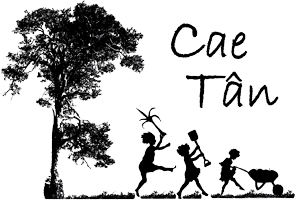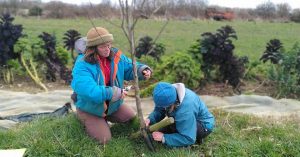In 2022 we received funding from ‘Farming the Future’ together with financial support from Social Farms & Gardens to develop agroforestry at our Furzehill site. The project was a partnership between The Orchard Project and Cae Tan. In addition Andy Dibben provided a consultancy report to inform the design.
What is Agroforestry?
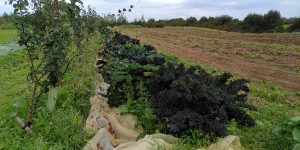
*An innovative but also historic method of farming, involving trees grown with crops or with animals.
*It describes a combination of animals/woodland/grassland/crops
*The term agroforestry includes interplanted orchards, wood pasture, forest gardens, alley cropping & hedgerows.
By adding in trees to an existing or planned farming system, some of the cropping/grazing area is lost. However it has been found that by adding the trees, many new benefits are gained, for example additional fruit yield, increased biodiversity, shelter for predatory insects, increased productivity, a healthy soil food web and increased resilience. In addition, Nitrogen fixing trees can be used to enhance soil nutrient levels. In a combined grazing system, shelter for animals is provided plus additional fodder. Considerations in adding the trees include making the most of a deeper root zone for the tree roots (shallower roots that impact on the growing space are removed during cultivation); size/shape of tree canopy – resulting shade and possible understory for the trees. Another issue to be considered is harvesting time and minimising any disruption that will cause in the field.
Choice of trees at Cae Tan
At Cae Tan the main aims for introducing trees into the rotation beds were to provide some increase protection against wind and to enhance biodiversity both above and below ground. So the tree rows are a mix of fruiting trees and native trees. There are four fruit tree rows in the field system and each row has a different understory – rhubarb, herbs or wildflowers. (Green manures may also be used). Three of the rows are (unusually) East to West, to fit in with the bed rotations which are East to West. One row in the second field is North to South which is more usual. This row is more densely packed with fruit trees as they will not cause shading problems. The native trees used in all the rows were chosen for light shade – rowan, birch, spindle, hazel and crab apple. These will be coppiced as needed, to keep them small and to provide woodchip to add to the field in order to boost soil carbon, increase organic matter, enhance soil biodiversity and nutrition. A diversity of fruit trees were chosen for their versatility, range of cropping times, ability to store, reliability of cropping, resilience to disease and yield. In addition, choosing trees suitable for the Welsh climate was a consideration, along with future climate resilience. Thus apple varieties that will do well in the future predicted climate, plus Welsh cherries and plums. The apples are nearly all are on MM106 medium rootstocks. However there is a larger M25 rootstock in the Northernmost row. We also planted a range of nut trees – 7 sweet chestnut plus 2 walnuts and various hazels, all to be coppiced on rotation. In the forest garden we added a diversity of fruit, with 100 new trees being planted across the site in total.
Designing the Agroforestry Project
A permaculture process was used to create the design, using ‘SADIM’ (Survey, Analysis, Design, Implementation, Maintenance). We started with a survey of all the people – growers, directors, trainees, members, volunteers and other site users to find out their thoughts on needs 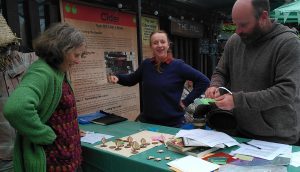 and wants and level of involvement. We surveyed the site (soil, weather, aspect, wind, sun, existing layout etc). There were four different aspects to the design – the tree rows within the rotation beds, a forest garden to be created in the young orchard, a foraging hedges and nut tree areas. The growers led the design of the tree rows as these would impact on the growing plan. Members and volunteers led the design of the forest garden, as this would be managed by a volunteer group in future. In total 40 people were involved in the surveying, designing and implementation of the project.
and wants and level of involvement. We surveyed the site (soil, weather, aspect, wind, sun, existing layout etc). There were four different aspects to the design – the tree rows within the rotation beds, a forest garden to be created in the young orchard, a foraging hedges and nut tree areas. The growers led the design of the tree rows as these would impact on the growing plan. Members and volunteers led the design of the forest garden, as this would be managed by a volunteer group in future. In total 40 people were involved in the surveying, designing and implementation of the project.
The Forest Garden
A group of volunteers and members came together to learn about forest garden principles, plants & design. The existing young orchard already had a hedge on two sides, which helped protect from the wind.
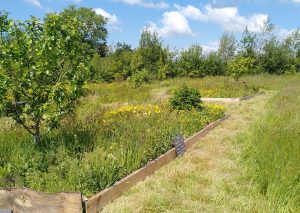
After several sessions learning the design skills needed, the various designs we had done came together into one overall design, with beds, paths, trees, a social circle and areas for wildlife. 25 people were involved in the design stage which was then offered up for comments from the Cae Tan members. The forest garden and agroforestry rows were planted in winter 2022/2023, with some plants being donated by members. We marked out the garden bed areas with cardboard & woodchip, then ran planting sessions to fill them in. Ideally we would have had time to sheet mulch the beds for an entire summer to properly reduce perennial weeds, but we had to work to the funding schedule. In the end we have learnt to love creeping buttercup and dandelions as a ground cover! We have timber bed-edging and slates for each bed showing the plants, giving some structure to the garden, but it continues to evolve and nature has begun to move things around.
We have used 4 layers in the forest garden – lower canopy (fruit trees), fruit bushes, herbaceous perennials and groundcovers. The beds with the most groundcovers in are doing really well. We have planted iberican comfrey as an early flowering pollinator and supplier of nutrients. One of the challenges was water – there was no tap in the field initially and during the first hot spring we had to barrow water from the neighbouring field. So a water catchment roof was set up, which also enabled us to create a small storage area for a few tools and materials. An additional challenge was the weather – it was cold and windy straight after planting until spring got going, and this killed off some of the plants, but we were able to buy in replacements. A final addition will be the implementation of a pond and bog garden.
Plant Lists
Tree Rows – APPLES – Discovery, Worcester Pearmain, Fiesta, Egremont Russet, Bramley, Stoke Red, Red Devil, Ellinsons Orange, William Crump, Tom Putt, Ashmead’s Kernel, Blenheim Orange, Channel Beauty. PLUS Denbigh Plum, Concorde Pear, Stella Cherry, Cambridge Greengage.
Existing orchard trees – APPLES – Ten Commandments, Kings Acre, Moss’s Seedling, Gascoigne Scarlet. PLUS Concorde Pear, Conference Pear, Cambridge Greengage, Beurre Hardy Pear, Vranje Quince.
New forest garden trees – Cambridge Greengage, Denbigh Plum, Farleigh Damson, Merryweather Damson, Nottingham Medlar.
Nut Trees – SWEET CHESTNUTS – Marron Comballe Seedling, Numbo Seedling, Belle Epine Seedling, Bourneet, Vignols. WALNUTS – Franquette & Broadview. HAZELS – Gunslebert, Tonda di Giffoni, Lang Tidlig Zeller, Cosford.
Forest garden plants – FRUIT BUSHES – blackcurrants, redcurrants, gooseberries, thornless loganberries, jostaberries, honeyberry, nepalese raspberries, eleagnus. PLUS various herbaceous perennials, medicinal herbs & groundcovers.
